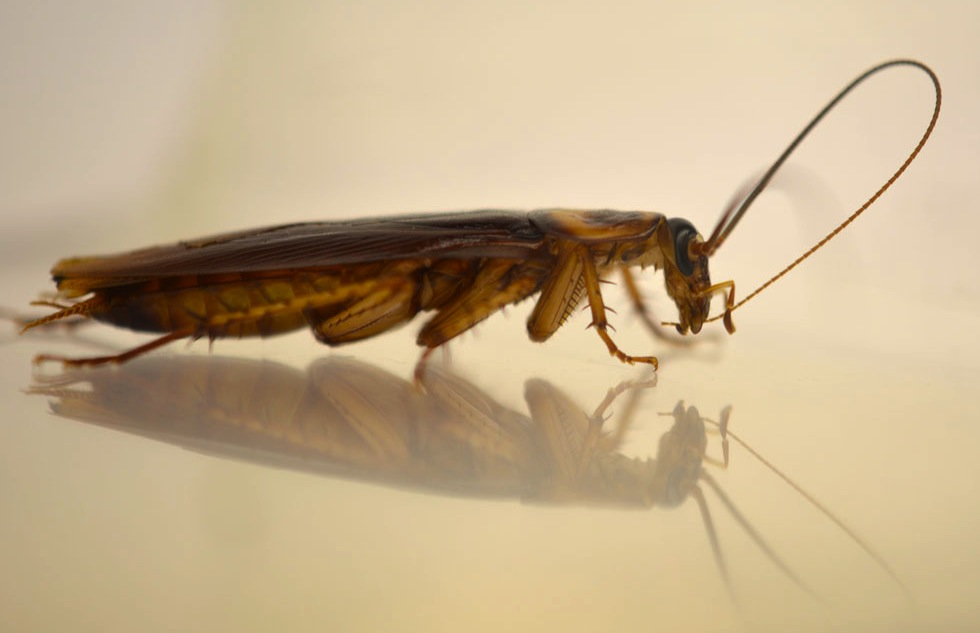Why Cockroaches Meticulously Groom Their Antennae
Just as humans scrub off to remove dead skin cells, sweat and dirt from the day, insects also busy themselves to keep clean
![]()
When encountering a two-inch American cockroach, most people quickly skedaddle the other way or raise a foot to stomp the little creeper out of existence. For those curious few who stick around to quietly observe the roach, however, the insect will inevitably fall into a certain diligent, repetitive motion. First, it reaches its spiny little roach feet up towards its head, then grips the base of one of its antennae and finally, as if it were spinning yarn at triple speed, threads the length of its antennae through its furiously working mouthparts.
Insects such as cockroaches, house flies and carpenter ants often engage in such antennae-grooming behavior. Like many animals, scientists know that insects frequently clean themselves, but few researchers have investigated just why bugs bother. Antennae serve not only to feel out the environment but also to sense odors, so researchers have long suspected that grooming keeps the antennae in top shape. But what, specifically, are they scrubbing from their bodies? Do roaches self-clean to remove bacteria or bits of gunk from their last meal?
To figure out just why roaches groom, lead author Katalin Böröczky and colleagues from North Carolina State University along with researchers from the Russian Academy of Sciences observed antennae-cleaning behaviors in a couple dozen adult male American cockroaches, describing their experiment today in Proceedings of the National Academy of Sciences. The researchers used an array of methods to restrain the roaches from self-grooming so that they could compare groomed and ungroomed antennae. In some cases, the scientists used a small plastic clip to tether one antenna at the base of the roaches’ heads. The frustrated insects repeatedly attempted to grab hold of their lassoed antenna but could not get a grip on it in order to clean it. Some roaches also had their mouthparts glued together while others were kept in a box too small to allow for self-grooming.
Here, you can see one of the roaches stymied by the plastic antennae blockers:
<iframe height="281" frameborder="0" width="500" allowfullscreen="" src="http://www.youtube.com/embed/OWmuZyzrdx0?feature=oembed"></iframe>
Over a period of 24 hours, the tethered antenna began to appear shinier than the other non-tethered one. Examining the shiny antenna with a scanning electron microscope revealed an unidentified substance blocking the roaches’ sensory pores and coating their antennae. The unclean antennae built up three to four times more of the stuff than the clean ones over the day.
To figure out what the unknown build-up was, the researchers took samples of it and analyzed it with gas chromatography, a technique that separates different components of a chemical compound. They found that the natural secretions that the cockroach gives off accounted for most of the substance–mostly fatty molecules that help regulate water loss in insects. Despite the seemingly sterile environment, other external contaminants were stuck on the antennae as well, including stearic acid from surfaces in the roaches’ container and geranyl acetate from the air.
The researchers guessed that this build up might impair the roaches’ ability to sniff out olfactory signals with their antennae. To test this hypothesis, they exposed roaches with groomed and ungroomed antennae to sex pheromones and other odors. Just as they suspected, roaches with clean antennae were more receptive to the odors around them than those with unclean ones. “We conclude that the disruption of grooming interferes with general olfaction,” the authors write in their paper.
Finally, to see if these findings extended to other insects, the researchers repeated their experiment in flies, ants and German cockroaches, all of which exhibited the same build up and loss of antennae function when prevented from self-grooming. They conclude that “our observations with four phylogenetically diverse species indicate that this hitherto unknown role for grooming is common to a wide diversity of insects.”
Just as humans scrub off to remove dead skin cells, sweat and dirt from the day, insects busy themselves to keep clean. While we may share this commonality with earth’s most abundant group of species, however, it may not be quite enough to inspire empathy for the next cockroach that finds its way into a closet or kitchen drawer.
/https://tf-cmsv2-smithsonianmag-media.s3.amazonaws.com/accounts/headshot/Rachel-Nuwer-240.jpg)

/https://tf-cmsv2-smithsonianmag-media.s3.amazonaws.com/accounts/headshot/Rachel-Nuwer-240.jpg)